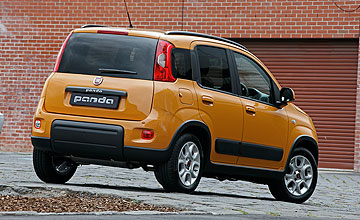BY BYRON MATHIOUDAKIS | 24th Oct 2013

Built in the same factory that made the legendary Alfa Romeo Alfasud, the five-door, five-seater, five-star safety-engineered urban runabout is absolutely brimming with design individuality inside and out, backed up by outstanding space efficiency and a solid, quality feel.
And if that weren’t all enough, the little Fiat is a corker to drive no matter which drivetrain option you encounter. More on that later.
In most markets the Panda is a deadly opponent to rival sub-B segment wannabes such as the Volkswagen Up, Suzuki Alto and Holden Barina Spark.
Fiat Group boss Sergio Marchionne must surely be proud of his bouncing baby firecracker.
So why is the most complete Italian car in living memory in danger of missing out on mainstream success in Australia.
In our minds, the base Pop – at $16,500 drive-away – is simply $1500 too expensive. In a price-sensitive market, similarly sized rivals such as the VW Up and Mitsubishi Mirage are between $1000 and $3500 lower down the price ladder respectively.
Plus, the more expensive Pandas with the awesome TwinAir two-pot turbo or four-cylinder turbo-diesel engines are all well north of $20,000 (and some are over $25K) drive-away, putting the feisty little Fiat right up among the 2013 game-changers: the Renault Clio IV, VW Golf VII and giant-slaying Ford Fiesta ST.
Take the $16.5K Pop - the good with the bad. It includes back doors with wind-down windows, three-row rear seating, face-level dash air vents and curtain airbags that the cheapest version of the VW doesn’t.
But last month the Germans struggled to sell 30 units, while the Mirage – which lacks the VW’s class but beats it on space-for-the-money – almost managed 600 sales. Australians simply won’t pay a hefty premium for their city runabout, not in this price-sensitive end of the market anyway.
Also, the Pop lacks some crucial items like electric mirror and seat height adjustment – making for an awkward driving position for some. And the cabin is prone to road-noise intrusion.
On the other hand, like all Pandas, the windows are deep for excellent all-round vision four adults should have no problem fitting inside comfortably there are child-seat anchorage points directly behind the rear backrest so as to not intrude into cargo space the suspension soaks up city street bumps like a much larger car the steering is responsively quick and delightfully tight for zippy handling and the chassis grips the road – even in slippery conditions – like a Cat’s Eye.
Plus, the ageing 1.2-litre four-cylinder petrol engine is a smooth and quiet operator, providing a sudden burst of power down low for fast take-offs, and a steady stream of torque in the middle to keep the show on the (open) road. And we love the stylised circular-square (Squircle) shapes peppering the Panda’s interior, from the classy dashboard and steering wheel to the aircraft-controller like look of the handbrake. Even the ceiling graphics are a pleasure to behold.
The 0.9-litre TwinAir version is an even more compelling drive, bringing that raspy and ready turbo two-cylinder tearaway to the table for more rapid off-the-mark acceleration, a greater turn of speed at every interval and exceptional fuel economy.
But we’d go for the five-speed manual, for the $1500-extra Dualogic robotised automatic lacks the former’s involvement, smoothness, and ease despite offering a lag-prone ‘Auto’ mode. And on longer journeys the lack of cruise control and noisy TwinAir soundtrack can become jarring.
Lastly, there is the Trekking – truly a unique proposition and in a class of its own.
But, seriously, while the torquey yet revvy 1.3-litre MultiJet turbo-diesel provides ample performance for a car as petite as this, it is manual-only, and – again – far too expensive, particularly as there is no all-wheel drive option to match the Trekking’s off-road-lite attitude. Remember, the price before on-roads is $24K.
At the risk of being a broken record, why can’t Fiat position the Pop under $15,000, the TwinAir from around $17,000, and the diesel in the low-20s? Then perhaps Australians – attracted by the truly fresh and alluring design – will experience the lively performance, responsive steering, tenacious handling, supple ride, built-in safety, and excellent packaging with the open mind that this fantastic little Italian rocket deserves.